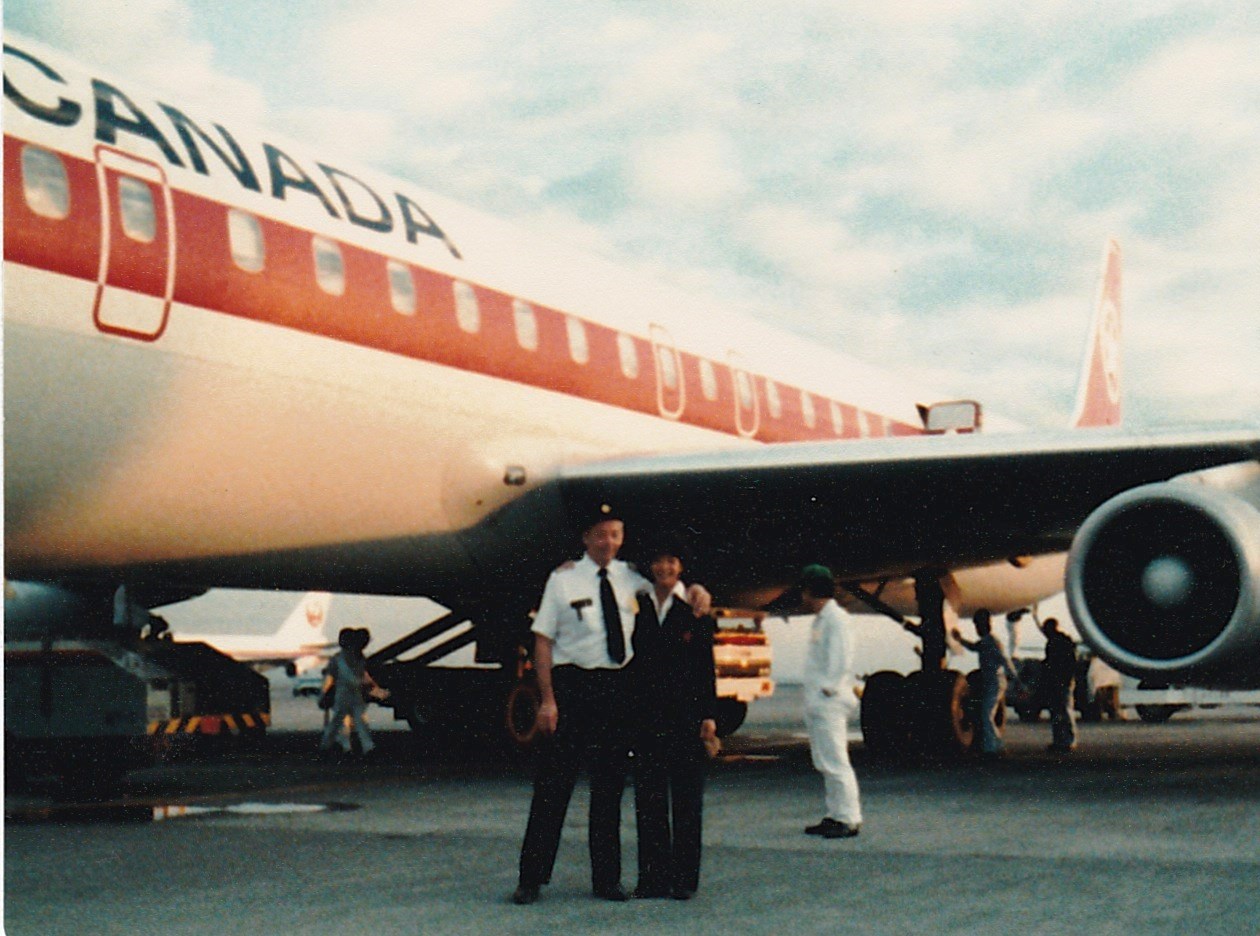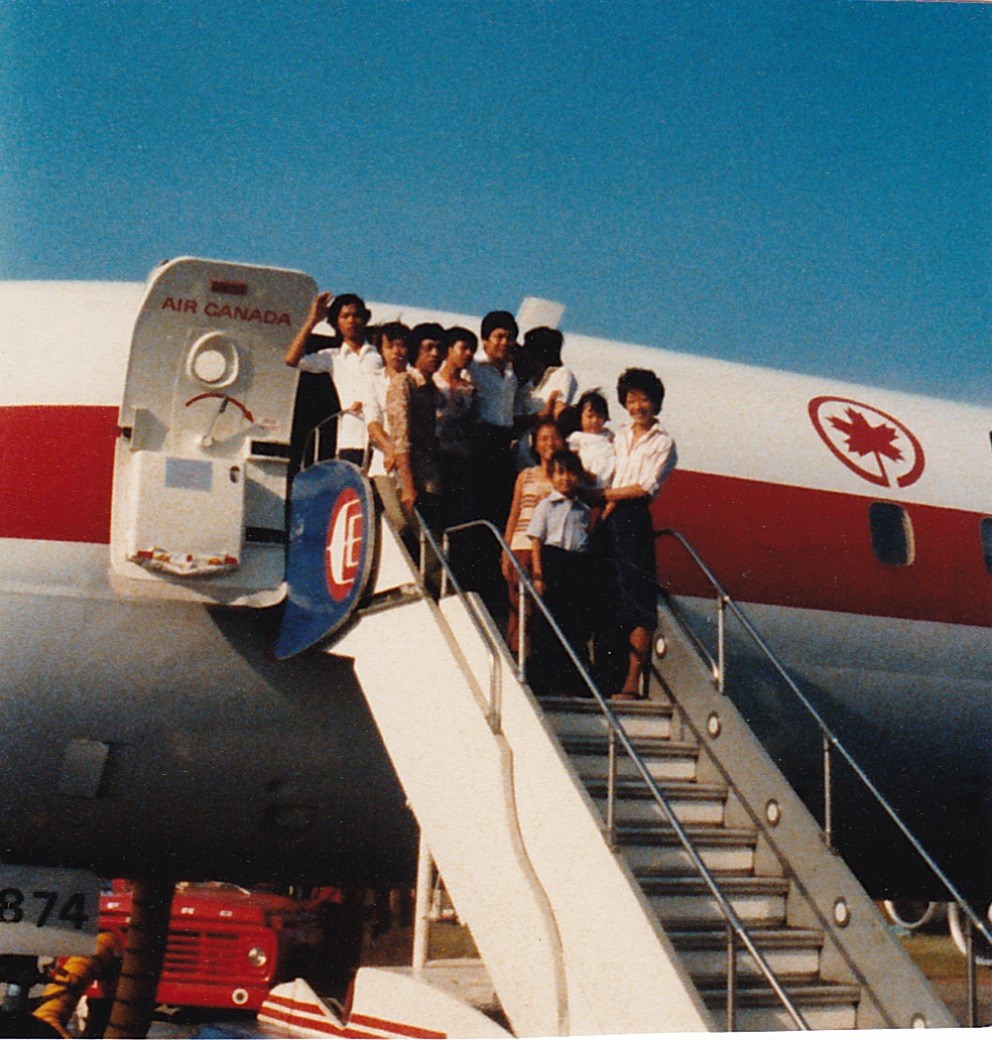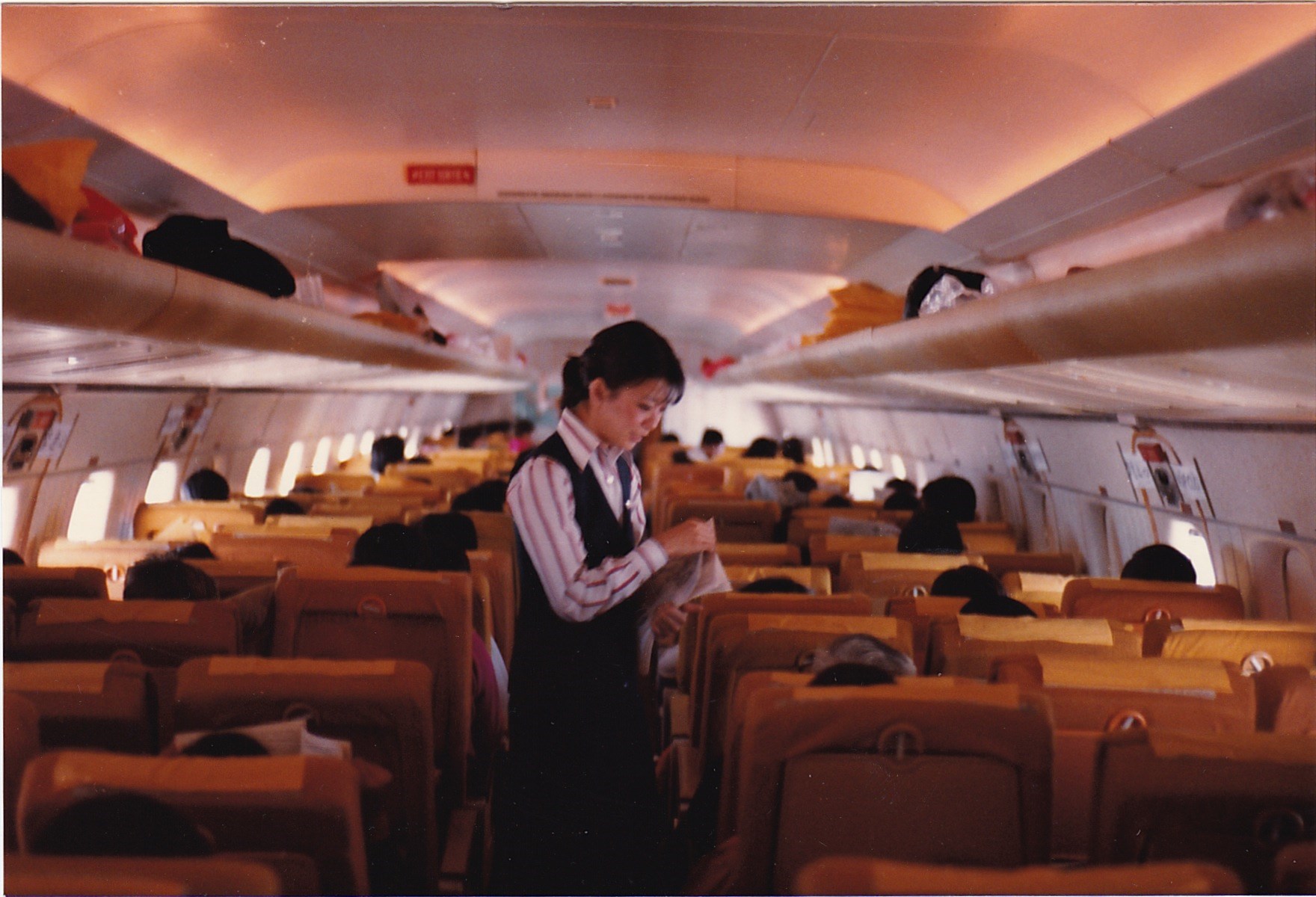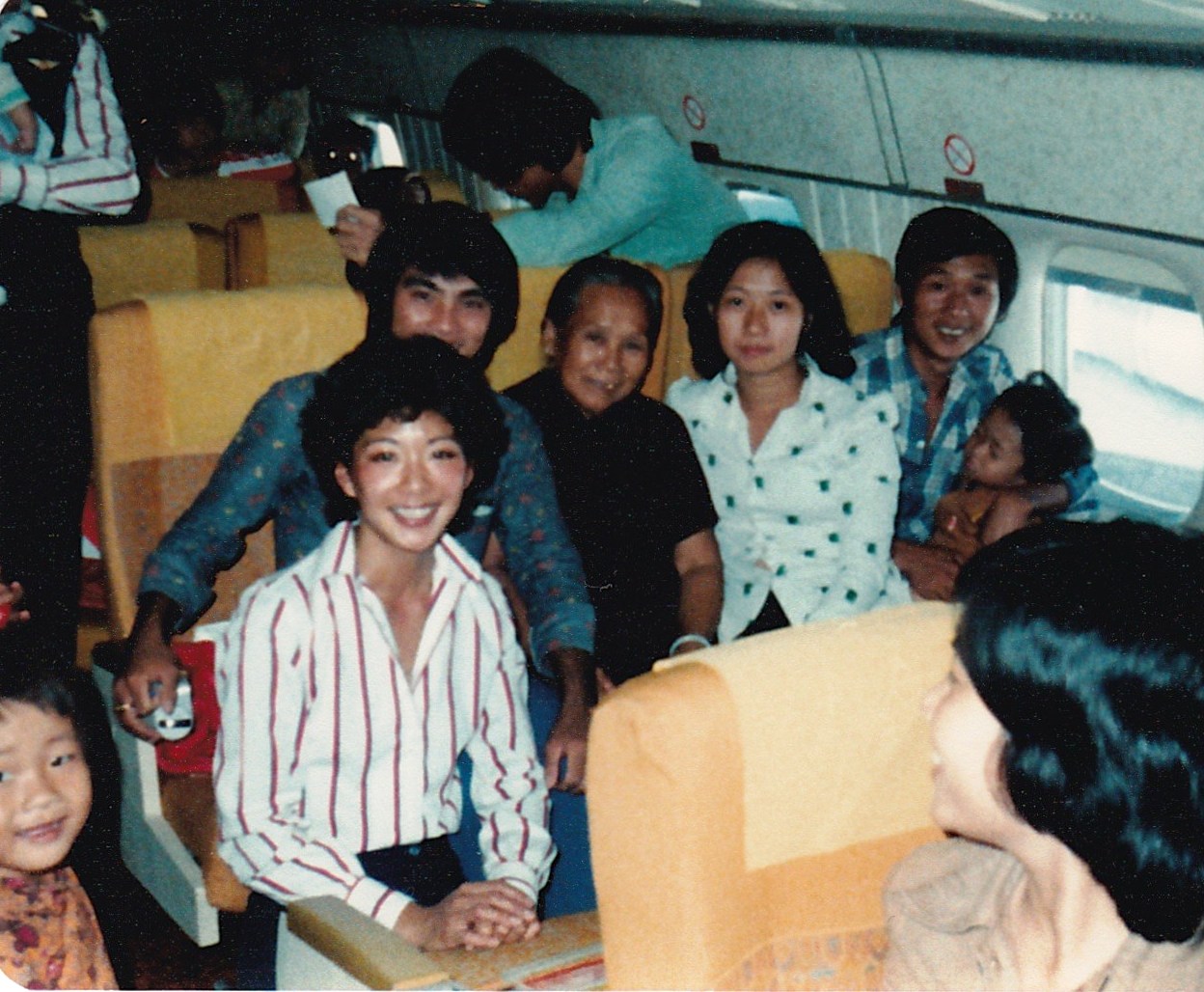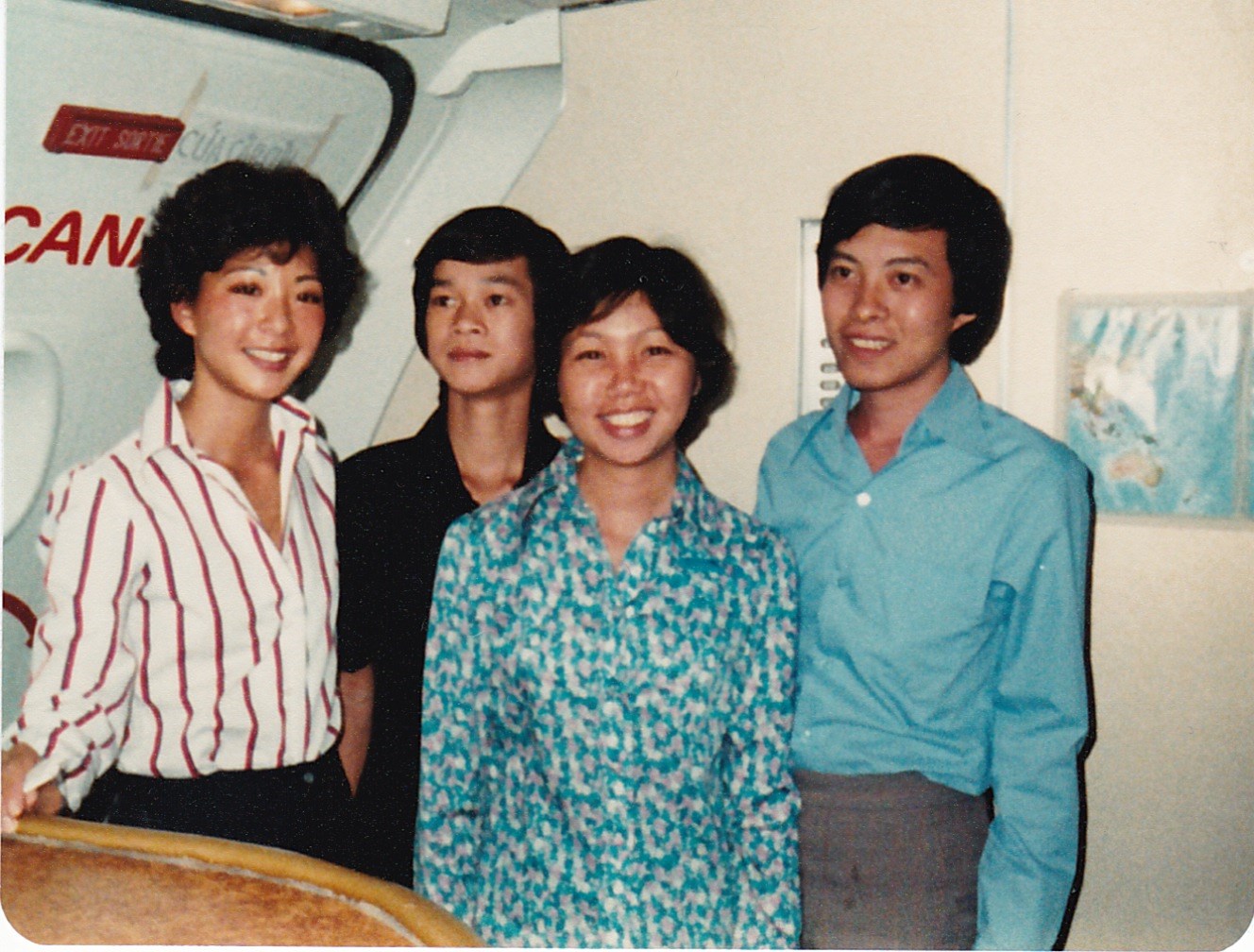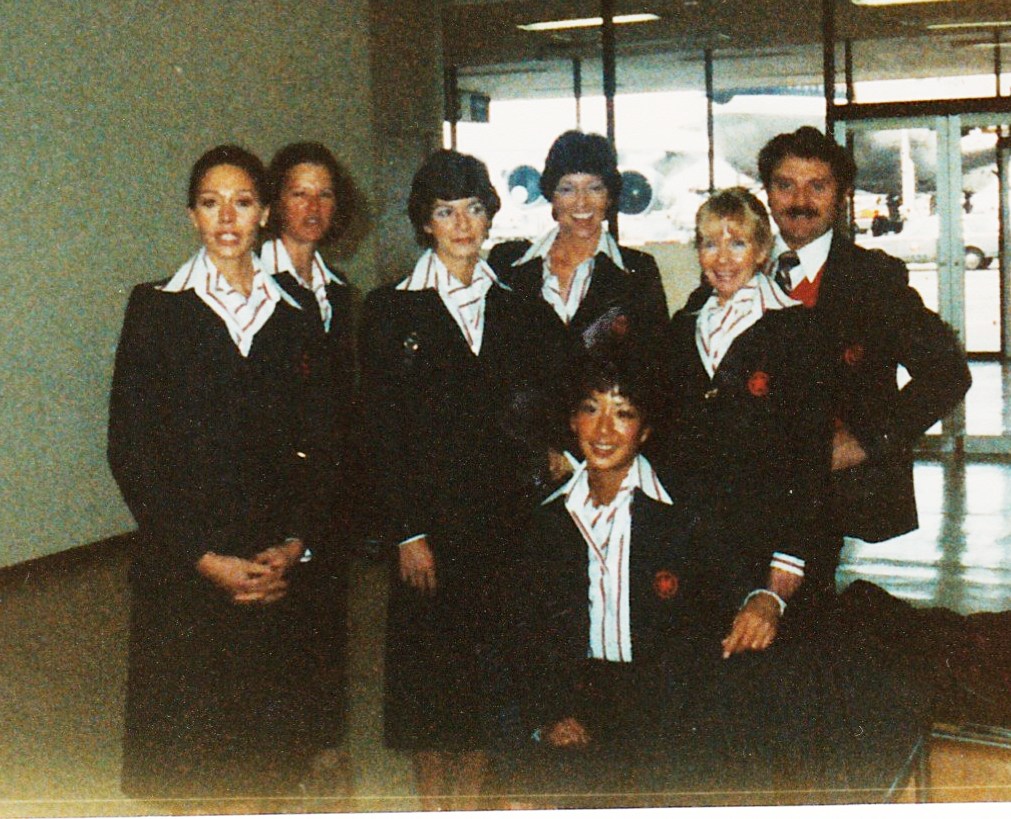Air Canada Vancouver-based crews were assigned to airlift Vietnamese refugees from various points in South-East Asia to major Canadian cities in 1979-1980. This refugee resettlement program would become one of Canada’s largest and most ambitious, bringing over 50,000 Vietnamese ‘boat people’ to our shores and throughout the country.
Memories to Unravel
Laid out before me on my desk are rows and rows of pictures from the winter of 1979 to spring of 1980. Yellow sticky notes jot down faded memories of Vietnamese children and babies sitting on galley counter-tops, a child finding a galley cubby hole to explore, the flight dispatcher with a baby in his arms, crews waiting on the tarmac, and the families without family. As the memories come into sharper focus, I see a photo, well actually 3 and I carefully tape them together, line up the horizon and the single file line of refugee after refugee waiting, ready to board Air Canada’s DC 8 Stretch bound for Canada. Looking into this photo catches my breath and nudges me back 40 years to a time in history that I have always held close to my heart. These photos hold powerful and deep memories that are ready to be shared and to find their way perhaps to all those Vietnamese families who took these flights with us on their final steps towards freedom. And to my, our, their country that is Canada.
In 1979, Vancouver based Air Canada crews were assigned to airlift Vietnamese refugees from Southeast Asia to major Canadian cities. As one of the larger Air Canada bases, Vancouver (YVR) was responsible for the complex logistics of the overseas operations that also involved the scheduling of aircraft and crew placements. From a crew perspective this meant the ferrying or flying empty aircraft without passengers to Kuala Lumpur, Singapore, Hong Kong and Bangkok to then turn around and pick up refugees to bring to Canada. This refugee resettlement program would become one of Canada’s largest and most ambitious, bringing over 50,000 Vietnamese ‘boat people’ to our shores and throughout the country. During this decade before deregulation, Air Canada’s overseas routes were mostly to Europe. To serve these European destinations, flight attendants were hired as bilingual in French or German. East-Asian-language speaking flight attendants were not common at the time. YVR had three in total: 1 Japanese, 2 Chinese of which I was one and thus assigned to the refugee charters. I did a lot of airlifts that took me away from home for up to 2 weeks each month. Being involved in this significant time in history had an enduring emotional effect upon me. It became a personal and life altering experience that began as it wrapped up: the stories, the pictures and the faces became part of my own story. To be able to write about it today, and to share the feelings connected with powerful images is both humbling and touching.
On the ground, across the tarmac at Kuala Lumpur Subang International Airport, we walked towards a low lying building on the edge of the runway and could see a few of our passengers looking back at us through open air windows. Some are meandering outside close to the building and the area is closed off by a chain link fence. It is early morning and already a humid, hot, slightly overcast day. The Air Canada crew is impeccably uniformed: navy uniforms, buttoned up vests, ties, crisp shirts, polished shoes. Even as we are perspiring, there is no rolling up the sleeves. It would seem too casual. Representing our country, Maple Leaf on the tail of our airplane, being Canadian and proud; it felt like we wanted to be at our best. We were about the meet our most important passengers. And we wanted them to feel safe with us.
Entering the building along the runway, there is no one in the huge room, but behind a large windowed opening with a wide ledge are faces upon faces looking out at us. Their eyes are smiling back, the tall and the short are jostling, leaning to be up close to the front as if to say ‘at last you’re here!’ I walked alone towards what felt like a huge sea of emotion. I didn't know who was more curious about the other, me or the refugees. I went from ‘feeling Canadian, then Asian, then Chinese’ and suddenly it didn't matter because all at once then there was laughter and we became one. It must have been my awkward attempts to find a common greeting with Mandarin, Cantonese, French and English as well as using my arms and facial expressions. That day, if humanity could be given a size, it would be beyond anything I’ve ever experienced: simply the biggest hug that wrapped around us all.
As the refugees entered the aircraft cabin, our story as crew and refugees began in earnest. All together in a small space, I could sense the hope, the nervousness, the fear, and the anticipation. The flight legs, their journey became one more step to freedom that must have felt surreal. In the single file line that once was, one is not able to see that a child has lost his mother, or young adult children leaving their parents behind in Vietnam, nor understand the tragedies that ripped apart individual histories. So it is in the airplane where the crew sees these fragmented lives, strands of families needing to sit together, close, all in one row even if there are not enough seat belts for them. There is no random chatter; it is quiet and the passengers can’t stop looking at us. After all these years, this sense of urgency has never left my heart.
And then there is the photo of a mother with tousled hair, head leaning against a yellow airline pillow, wrapped in a red blanket. Seat 6A, knees pressed against the aircraft wall and cradled on her lap is a young child, maybe a year old with his little fingers stretched out on the window pane. He is wearing a sweater, a toque, surely in acknowledgement of the Canadian winter. Both are looking out and beyond the aircraft window, where the landmarks are only sky, cloud and ocean. I look at her and I can feel the gentleness of her gaze and voice. Yet at the same moment I worry about them or perhaps it is that I feel for what they must do to begin a new life in a new country.
Once the DC 8 lifted off, the journey included several flight legs without passenger deplaning and several crew changes in order to reach final destinations in Canada. During these flight hours on board is when Air Canada crews experienced the unraveling of stories, the humanity, the trust and the hope. Sharing this space with our special passengers in privacy, away from media and the public was a privilege. Tucked in tight with families in their cramped row of seats, we listened and shared their stories of loss, hardship and grief. We laughed and we cried. For these trans Pacific crossings, the Vietnamese became our family and we comforted one another by doing what all families do. We would gather the children and prop them up on the gallery counters for playtime, carry the babies for walks up and down the aisles while families slept.
I have so many ‘family pictures’ from these airlifts and I am in all of these – I knew at the time that I might have represented an absent, lost or missing family member. Being the only Asian speaking flight attendant on the crew, I became the resident Chinese-Canadian on board that gave many of my passengers their first glimpse of the possibilities in Canada. It was like being adopted for the duration of a long flight leg. And real proof that Canada might just be the right place to start over. Now 40 years on from the stories that unfolded in that DC 8 airplane, we now know that hope has a way of lasting for a long, long time and new stories are about to be told.
Written by Air Canada Flight Attendant Louise Chong. Louise is Canadian-Chinese and worked with Air Canada from 1972-1996 (26 years service). She is currently married with two children and lives and works in Calgary as a designer.
